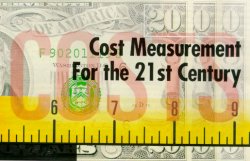|
|
Cost Measurement for the 21st Century by Mark Arend
Workpoint accounting quantifies the direct and indirect costs associated with an increasingly diverse workplace. Ideal candidates are business organizations transitioning to new, non-traditional work processes, organizational arrangements, and work settings. Companies well-suited for workpoint accounting are those with a flat, non-hierarchical organizational structure; a mobile work force; team-based organizational structures; network-based systems, including the Internet; and a global marketing and customer-service presence. The workpoint cost approach goes beyond both traditional accounting practices and activity-based costing (which converts traditional financial information to reflect actual activities, processes and tasks of an organization) by identifying employee workpoint costs wherever they exist. Proponents of the concept argue that as organizations grow to become more global, automated and service-oriented, the traditional ways of measuring and analyzing financial information become less relevant. “The kinds of infrastructure that are put in place to support the global company are such that we need a new measurement process, a new accounting process to account for the interplay of the technology and the facility [infrastructure] domains,” says Michael A. Bell, managing director, Price Waterhouse LLP, New York, and past president of the International Development Research Council. Workpoint cost measurement looks at five layers of costs associated with the individual worker: direct space, direct support and equipment, connectivity, indirect space and indirect support and equipment. Uses include measuring a business unit’s performance relative to specific workpoint cost items; refining allocation of an organization’s financial, human and other assets; comparing occupancy costs with comparable business units in other companies and industries; and weighing alternative ways of deploying business strategies. Commonwealth Advisors, a New York consultancy pioneering much of the work in this field, is working with Link Systems, Stamford, Conn., to develop a module of Link?s corporate real estate system to do the job. “Link Systems has the ability to pull in data from the personnel system, the real estate lease system and other areas, which probably will produce 90-plus percent of the necessary information,” says Michael S. Schmidt, a principal at Commonwealth Advisors. Corporate units most likely to be involved in the exercise are corporate real estate, accounting, human resources and information technology, or MIS. All four groups — and the managers thereof — have lots at stake riding on the outcome of a thorough workpoint accounting analysis of corporate resource allocation. While problems won’t necessarily occur, careful planning ahead of time that includes setting clear objectives and expectations of those involved will minimize the likelihood of turf battles half-way through the exercise. “A senior resources or infrastructure manager will emerge from this exercise to which all of these [functions] report,” says Schmidt. “We feel that it ought to be a real estate executive with a strong financial background — a lot of them have come from the finance side of the business — who grabs hold of that role.” SS
|
Subscribe to Site Selection Magazine
| SiteNet |
Feedback |
Search |
many sources. Conway Data, Inc. does not warrant any content to be accurate or current.


 APRIL/MAY 1998
APRIL/MAY 1998 Some executives wonder whether telecommuting and other “dynamic workplace” structures really are cost-efficient. Others seek more accurate tools with which to measure occupancy, equipment and human resources costs tied to specific projects, departments, and business lines. A new accounting methodology, called workpoint cost accounting, may shed light on these areas.
Some executives wonder whether telecommuting and other “dynamic workplace” structures really are cost-efficient. Others seek more accurate tools with which to measure occupancy, equipment and human resources costs tied to specific projects, departments, and business lines. A new accounting methodology, called workpoint cost accounting, may shed light on these areas.